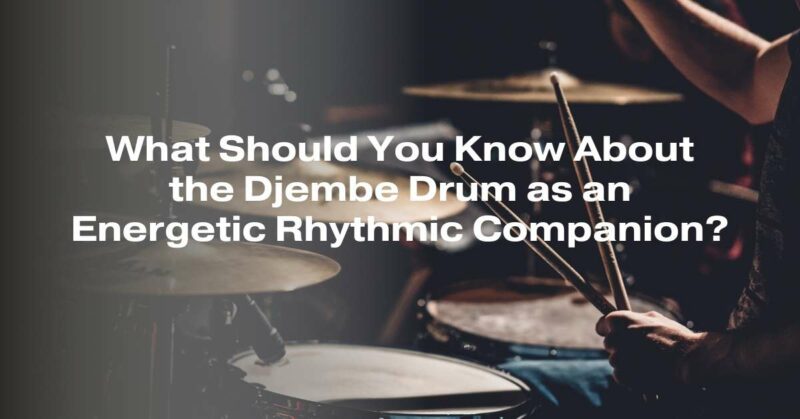The Djembe drum, a mesmerizing instrument with deep cultural roots, is more than just a musical tool; it’s an energetic rhythmic companion that has captivated hearts and minds for centuries. Originating from West Africa, particularly Mali, Guinea, Ivory Coast, and Burkina Faso, the Djembe drum carries with it a rich history, cultural significance, and a unique power to connect people on a spiritual and energetic level. In this comprehensive article, we will delve into the world of the Djembe drum, exploring its history, construction, cultural significance, and the profound impact it can have as an energetic rhythmic companion.
The History of the Djembe Drum: A Journey Through Time
The Djembe drum’s history is a tapestry woven with threads of tradition, spirituality, and community. Its roots can be traced back over 1,000 years, making it one of the oldest known percussion instruments in the world. The word “Djembe” itself comes from the Malinke language, spoken by the Mali people, and means “to gather together in peace.”
Traditionally crafted by skilled artisans, the Djembe drum is made from a single piece of carved hardwood, often from African species like the Lenke (Lengue) tree, which is known for its excellent acoustic properties. The drumhead is typically made from goat, cow, or synthetic skin, stretched taut over the drum’s open-ended body. Its unique shape – a wide, rounded bottom with a narrow top – not only contributes to its iconic sound but also allows for an impressive range of tones.
The Djembe’s Cultural Significance: A Symbol of Unity and Tradition
The Djembe drum holds immense cultural significance in West African societies. It is not merely an instrument; it’s a symbol of community, spirituality, and identity. In many West African cultures, the Djembe is considered a sacred object, and its rhythms are used in various traditional ceremonies, including births, weddings, funerals, and initiations.
Beyond its ceremonial roles, the Djembe is an essential tool for communication. In the hands of skilled drummers, it can mimic the rhythms of spoken language, conveying messages and stories across long distances. This ancient form of communication played a crucial role in the history of West African societies and continues to be a vital part of their cultural identity.
The Djembe Drum in Modern Times: A Global Phenomenon
In the 20th century, the Djembe drum began to spread beyond its West African origins. Musicians and enthusiasts from around the world were drawn to its captivating rhythms and unique sound. This global interest led to the development of a vibrant international Djembe community, with workshops, festivals, and performances taking place on every continent.
One of the key figures in popularizing the Djembe in the West was Mamady Keïta, a renowned Guinean drummer and teacher. His efforts, along with those of other skilled instructors, have made it possible for people from diverse backgrounds to learn and appreciate the art of Djembe drumming.
The Djembe as an Energetic Rhythmic Companion: Healing and Connection
The Djembe drum is not just a musical instrument; it is also an energetic rhythmic companion that can have a profound impact on individuals and communities. Here are some ways in which the Djembe drum serves as a source of healing and connection:
- Physical and Emotional Release: Playing the Djembe can be an intense physical activity. The act of drumming releases endorphins, which can alleviate stress, anxiety, and depression. The rhythmic vibrations of the drum also have a soothing effect on the nervous system.
- Community and Connection: Djembe drumming often involves group participation. Drum circles bring people together, fostering a sense of community, belonging, and unity. The shared experience of creating music can break down barriers and promote understanding among diverse groups.
- Spiritual and Energetic Connection: Many believe that the Djembe drum has a unique ability to connect individuals with their inner selves and with higher spiritual realms. Drumming can induce altered states of consciousness, facilitating meditation and self-exploration.
- Cultural Appreciation: Learning to play the Djembe allows individuals to delve into the rich cultural heritage of West Africa. It fosters an appreciation for the traditions, stories, and values of these vibrant societies.
- Personal Growth and Empowerment: Mastering the Djembe drum takes time and dedication. Learning to play it can be a journey of personal growth, self-discipline, and empowerment.
Conclusion: The Djembe Drum as an Energetic Rhythmic Companion
The Djembe drum is not just an instrument; it’s a living testament to the power of music and rhythm to transcend cultural boundaries and connect people on an energetic and spiritual level. Its rich history, cultural significance, and ability to heal and unite make it a truly extraordinary companion in the world of music and beyond. Whether you are a seasoned drummer or someone looking to embark on a musical journey, the Djembe drum has something profound to offer, inviting you to experience the magic of rhythm and the beauty of cultural heritage.


